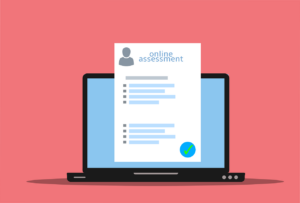Are you preparing for the NCLEX exam and wondering what the CAT exam format entails? The CAT Exam NCLEX is a computerized adaptive test that adapts to your individual skill level, providing a more efficient and accurate assessment of your nursing knowledge. Understanding the CAT exam format is crucial for your success on the NCLEX, and this article will provide you with the necessary information to prepare for the exam.
In this article, you will learn about the structure of the CAT exam NCLEX and how computerized adaptive testing works. You will also find tips and strategies to help you prepare for the exam and interpret your results. Additionally, we will provide you with resources and support to help you succeed on the CAT exam NCLEX.
So, let’s dive in and gain a better understanding of the CAT exam format.
Key Takeaways
- CAT Exam NCLEX is a computerized adaptive test used to assess nursing candidates’ knowledge, skills, and abilities to provide safe and effective care to patients.
- The exam uses a computer algorithm that adapts the difficulty of the questions based on the candidate’s previous answers, making time management crucial.
- To prepare for the CAT Exam NCLEX, candidates should practice with computerized adaptive testing software and take practice tests, and use test-taking strategies and study materials specific to the NCLEX exam.
- Analyzing performance can help identify areas for improvement and focus study efforts on areas that need the most attention.
Overview of the CAT Exam NCLEX
Let’s take a quick look at the CAT Exam NCLEX and get a feel for what it’s all about.
The CAT Exam NCLEX, or Computerized Adaptive Testing Exam National Council Licensure Examination, is a computerized test used to determine if a nursing candidate is qualified to become a licensed nurse. This format is used by the National Council of State Boards of Nursing to ensure that all nurses have the same level of competence before they can practice.
The importance of the CAT Exam NCLEX cannot be overstated. It’s designed to assess the nursing candidate’s knowledge, skills, and abilities to provide safe and effective care to their patients. The exam uses a computer algorithm that adapts the difficulty of the questions based on the candidate’s previous answers. The more correct answers they provide, the harder the questions become.
This format ensures that the exam is both efficient and effective in determining the candidate’s readiness to become a licensed nurse.
Understanding Computerized Adaptive Testing
So, you’re curious about computerized adaptive testing? This testing format is designed to adapt to your abilities as you take the exam, giving you questions that are tailored to your skill level.
Benefits of CAT include a more efficient testing experience, with fewer questions needed to accurately assess your knowledge, and a fairer assessment for all test-takers.
Keep in mind that CAT is different from traditional testing formats, so it’s important to understand how it works before you take the exam.
How It Works
Understanding how computerized adaptive testing works can be intimidating, but it’s essential to grasp the format to feel confident and prepared on exam day. Here are four key things to keep in mind when taking a CAT exam:
-
The adaptive algorithm tailors the difficulty of the questions to your ability level. This means that the computer will give you easier or harder questions based on how well you’re doing on the exam.
-
You can’t skip or go back to previous questions. Once you answer a question, you can’t change your answer or return to it later in the exam.
-
The first few questions are crucial. The computer will determine your ability level based on how well you do on the first few questions, so it’s important to take your time and answer them carefully.
-
Time management is key. Since the computer adjusts the difficulty of the questions based on your performance, you may end up spending more time on some questions than others. Make sure to keep an eye on the clock and pace yourself accordingly.
By keeping these test taking strategies in mind and understanding how the adaptive algorithms work, you’ll be better equipped to tackle a CAT exam with confidence.
Benefits of CAT
You’ll be pleasantly surprised by how much more efficient and accurate your test results will be with this innovative testing method.
The benefits of CAT are numerous. One of the biggest advantages is its effectiveness in testing your knowledge and abilities. The test adapts to your performance level, so you’ll be asked questions that are appropriate for your skill level. This means you won’t waste time answering questions that are too easy or struggle with questions that are too difficult.
Another advantage of CAT is that it allows for quicker and more accurate test results. Traditional tests require a set number of questions, regardless of the test taker’s ability. This can lead to inaccuracies in scoring and a longer testing period.
With CAT, the test adapts to your performance level, so you’ll only be asked the number of questions necessary to determine your ability level. This means you’ll receive your test results faster and with greater accuracy.
Overall, the benefits of CAT make it a preferred testing method for both test takers and test administrators.
Differences from Traditional Testing
If you’re used to taking traditional paper-and-pencil tests, the computerized adaptive testing format may feel like a whole new world. Here are some key differences between the two testing formats that you should be aware of:
-
Advantages of CAT:
-
CAT is more efficient. Because the test adapts to your performance level, you’ll only see questions that are appropriate for your skill level. This means you’ll spend less time on questions that are too easy or too difficult for you, and more time on questions that will actually impact your score.
-
CAT is more accurate. Traditional tests assign the same questions to every test taker, regardless of their skill level. This means that the test may be too easy for some test takers or too difficult for others, leading to inaccurate scores. CAT, on the other hand, adapts to your skill level, which means that your score will be more accurate and reflective of your true abilities.
-
Comparison to Paper based Testing:
-
In paper-based testing, all test takers receive the same set of questions, regardless of their skill level. This means that some test takers may be asked questions that are too easy or too difficult for them, leading to inaccuracies in their scores.
-
In computerized adaptive testing, the test adapts to your skill level. This means that you’ll only see questions that are appropriate for your level of knowledge, which will result in a more accurate score. Additionally, since CAT is computerized, you’ll receive your score immediately after completing the test, whereas with paper-based testing, you may have to wait several weeks for your scores to be processed.
Preparing for the CAT Exam NCLEX
To get ready for the CAT Exam NCLEX, make sure you practice with computerized adaptive testing software and take practice tests to get a feel for the format. This will help you understand the way the test adapts to your level of knowledge and how to pace yourself throughout the exam.
Additionally, you should consider using test-taking strategies and study materials specific to the NCLEX exam. Some test-taking strategies that may be helpful include eliminating obviously incorrect answer choices, identifying key words in questions and answers, and practicing time management techniques.
You may also want to use study materials such as review books, flashcards, and online resources to help you prepare for the content of the exam. Remember to stay focused, stay organized, and stay positive throughout your preparation process.
With dedication and hard work, you can be successful on the CAT Exam NCLEX.
Taking the CAT Exam NCLEX
On exam day, you’ll be required to arrive at the testing center at least 30 minutes before your scheduled start time.
During the CAT exam NCLEX, you can expect to face a computerized adaptive testing format that will adjust the difficulty level of your questions based on your performance.
To succeed on the exam, it’s crucial that you follow a few tips, such as managing your time effectively and staying calm under pressure.
Exam Day Procedures
Before your CAT exam, it’s important to familiarize yourself with the exam day procedures to ensure a smooth testing experience.
Start by creating an exam day checklist to ensure you have all the necessary items, such as your identification and testing ticket.
Make sure to arrive at the testing center early to allow time for check-in and to settle any nerves.
Once you’re settled in, take a few deep breaths to calm any test anxiety.
Remember, the CAT exam is adaptive, meaning the difficulty level of the questions will adjust based on your answers.
Don’t waste time stressing about getting every question right.
Instead, focus on answering to the best of your ability and pacing yourself throughout the exam.
With a little preparation and a calm mindset, you’ll be ready to tackle the CAT exam with confidence on exam day.
What to Expect
Now that you know the exam day procedures, it’s time to talk about what you should expect during the actual exam. Don’t worry, we’ll guide you through it.
First off, it’s important to know that the CAT exam format is designed to adapt to your level of knowledge. This means that the questions you’ll get are tailored specifically to your performance, and the computer will adjust the difficulty of the questions based on your answers. To help you prepare for this unique format, here are a few things to expect during the exam:
-
The exam will start with a few easy questions to gauge your level of knowledge.
-
As you answer more questions, the computer will start to adjust the difficulty level based on your performance.
-
You may notice that the questions are getting harder, but don’t let this discourage you. It’s just a sign that the computer is trying to find your level of knowledge.
-
You’ll have a limited amount of time to answer each question, so it’s important to manage your time wisely.
Test anxiety and time management are two common challenges that many test-takers face. However, with a little preparation and practice, you can overcome these challenges and feel confident on exam day. Remember to take deep breaths, stay focused, and trust in your abilities. Good luck!
Tips for Success
To excel on test day, it’s crucial to follow these helpful tips for success.
First, prioritize time management. Since the CAT exam is adaptive, the computer will adjust the difficulty level of the questions according to your answers. This means that the more difficult questions you answer correctly, the harder the next questions will be. Therefore, it’s important to allocate your time wisely and not get stuck on one question for too long. If you’re unsure about an answer, make an educated guess and move on to the next question. Remember, you can always go back to unanswered questions later if you have time.
Second, manage test anxiety. The CAT exam can be stressful, but it’s important to stay calm and focused throughout the test. Try deep breathing exercises or visualization techniques to help relax your mind and body. Additionally, make sure to take breaks and stretch during the test to prevent physical tension. Remember, your mindset can greatly impact your test performance, so stay positive and confident in your abilities.
By following these tips, you can increase your chances of success on the CAT exam.
Interpreting Your Results
Understanding your results on the CAT exam can be an exciting and informative process, allowing you to gain insight into your strengths and weaknesses as a test-taker. Score interpretation is the first step in understanding your results.
The CAT exam is scored on a scale of 0-999, with a passing score of 400. Your score is determined by the number of questions you answered correctly and the difficulty level of those questions. Therefore, the higher your score, the better you performed on the exam.
Performance analysis is another important aspect of interpreting your CAT exam results. This analysis provides you with a breakdown of your performance by content area. This breakdown can help you identify areas where you did particularly well and areas where you need to improve.
By analyzing your performance in this way, you can focus your study efforts on the areas that need the most attention, ultimately improving your chances of success on future exams.
Resources and Support
You’ll find plenty of resources and support available to help you prepare for and succeed on this challenging test. The National Council of State Boards of Nursing (NCSBN) offers a variety of support services, including an online tutorial and practice exam, candidate bulletin, and frequently asked questions section. These resources are designed to help you understand the format, content, and scoring of the exam, as well as provide tips for effective study and test-taking strategies.
In addition to the NCSBN resources, there are many commercial test prep companies that offer study materials and support services for the NCLEX. These companies provide a range of materials, including online courses, study guides, flashcards, and practice exams. While some of these services can be expensive, they can also be a valuable investment in your future career. It’s important to do your research and choose a reputable company that offers high-quality study materials and support.
Frequently Asked Questions
What is the passing score for the CAT Exam NCLEX?
When it comes to the passing score for the CAT Exam NCLEX, it’s important to understand the scoring criteria.
While there is no set passing score, the exam is designed to determine your level of competency in nursing.
This means that the more questions you answer correctly, the higher your chances of passing.
To prepare for the exam, it’s recommended that you focus on studying the content areas that you struggle with the most.
This can be done through a variety of preparation strategies such as practice exams, reviewing study materials, and seeking out additional resources.
By putting in the time and effort to prepare, you can increase your chances of achieving a passing score on the CAT Exam NCLEX and becoming a licensed nurse.
Can you retake the CAT Exam NCLEX if you fail?
If you fail the CAT Exam NCLEX, you can definitely retake it. However, exam retake policies vary depending on the state or country where you’re taking the test. Some may allow you to take it again right away, while others may require a waiting period before you can retake it.
Make sure to check with your testing center or the regulatory body in charge of licensing in your area to know the specific policies. In any case, it’s important to review your performance, identify your weaknesses, and study harder to increase your chances of passing on your next try.
How long is the CAT Exam NCLEX valid for?
The validity period of the CAT exam NCLEX is dependent on the state in which you are seeking licensure. Each state has its own regulations regarding the renewal options for the exam.
Some states require that you retake the exam every few years to maintain your license, while others offer renewal options such as continuing education credits. It’s important to check with your state board of nursing to determine the validity period and renewal options for the CAT exam NCLEX.
Are there any age restrictions for taking the CAT Exam NCLEX?
To take the CAT Exam NCLEX, there are age eligibility requirements that you must meet. There’s no minimum age requirement, but you must be at least 18 years old to register for the exam. Additionally, you’ll be required to pay an exam fee. The cost varies depending on the state or territory where you plan to take the exam.
However, regardless of your age or the cost of the exam, you must pass the CAT Exam NCLEX in order to become a licensed nurse.
Is there a limit to how many times you can take the CAT Exam NCLEX?
You may be wondering if there’s a limit to the number of times you can take the CAT exam NCLEX. Unfortunately, the answer is yes.
You are only allowed to take the exam a maximum of eight times per year, with a minimum of 45 days between each attempt. This is to ensure that you have enough time to prepare and improve your skills before trying again.
However, there are some advantages to the computerized adaptive testing format used by the CAT exam NCLEX. For one, it adapts to your performance level, meaning that the questions become more or less difficult based on how well you are doing. This makes the exam more efficient and accurate, as well as less stressful for test takers.
Additionally, research has shown that CAT outperforms traditional paper-based testing in terms of accuracy and efficiency.
So, while there are limits to how many times you can take the CAT exam NCLEX, the benefits of the computerized adaptive testing format make it a worthwhile and effective way to assess your nursing skills and knowledge.
Conclusion
So now you know all about the Computerized Adaptive Testing format used in the CAT Exam NCLEX. You understand the benefits of this format, as well as how to prepare for and take the exam.
But what happens after you take the test?
Once you receive your results, it’s important to interpret them correctly. Don’t be discouraged if you don’t pass on your first try. Use the feedback provided to identify areas where you need to improve, and create a study plan that addresses those weaknesses.
Remember, the goal of the CAT Exam NCLEX is to ensure that you’re prepared to become a safe and effective nurse, so take the time to learn from your results and keep working towards your goal.
Good luck!































































































































